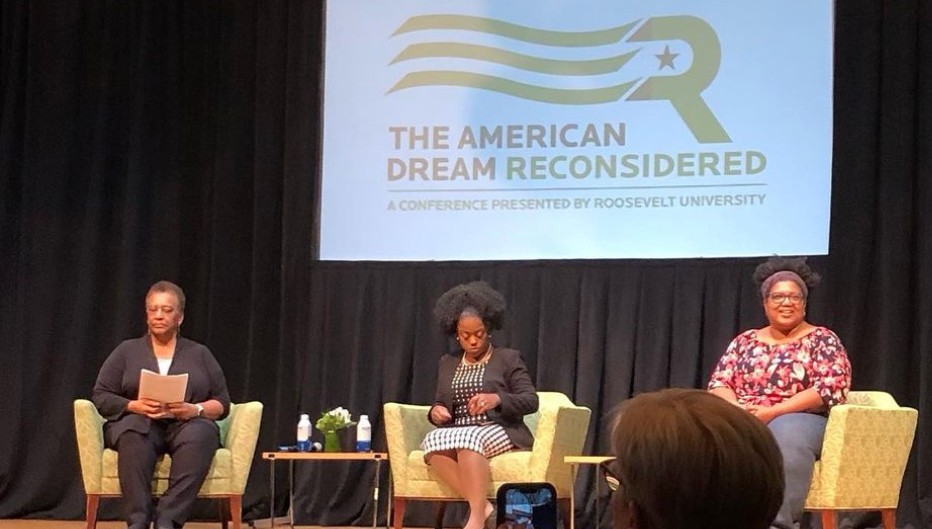
Reproductive rights, classroom curricula and Black female activism were some of the topics discussed at the 2023 American Dream Reconsidered Conference held in October. Hosted at the University Loop Campus and adjoining Auditorium Theatre, the three-day event brought scholars, activists and artists together to address the persistent inequities facing many Americans.
“Mind, Body and the American Dream” was the theme for this year’s conference, with the emphasis on how bodily autonomy and expression are under threat in the spheres of healthcare, education and athletics.
In the session “Our Bodies, Our Performance,” David Kjar, Associate Professor of core studies and music history at Roosevelt University, joined with graduate students Julien Ng, Kristina Mucha, Conner Feyen and Magda Travis to open a discussion about understanding the relation between a performance and the performers.
To discuss the idea of the relation between a performance and performers, they first discussed what it meant to each of them to be a performer. As a group, they noted that it means to connect with others and other cultures. Tavis noted, “We need to be able to talk about how different bodies performing the same work are perceived differently…how are people perceiving me? How do I perceive myself in these works? Do I feel a connection to them, am I at odds with my connection to them on a personal level?”
Together the panelists reviewed publication evaluation worksheets (PEWs) and listened to a student submission asking the question, “Why do we continue to hold space for embodied technique from problematic creators?”. Reviewing this, they discussed if it is possible to separate art from the artist and continue to use the art of infamous individuals. Discussing this, they concluded that it can often be difficult to separate the two since they are closely intertwined with one always drawing from the other.
In “The Embodied Performer,” the Chicago College of Performing demonstrated how the body becomes an instrument with the coordination of the mind and body.
The performances started with a performance of Act IV of an originally devised piece “A Wave o’the Sea” directed by Sarah Taylor and choreographed by Claire McFarland. This performance utilized the art of dance and acting to emphasize and project the shifts of emotion in the work. Taylor noted, “’A Wave o’the Sea’ is a marriage between Shakespeare and dance. If Shakespeare holds the mirror out to nature, then dance, perhaps, reflects the spirit within.”
Next to perform was a chamber music performance by the Icarus Ensemble, performing Robert Schumann’s Piano Quintet in E-flat Major, Op. 44. As instrumentalist, the group is limited to the sound their instruments emit and confined within the space that they sit. To convey meaning the performers utilize eye contact, body motion and gestures for certain musical ideas and practice in a manner that allows that group to create a cohesive persona for the performance. With an emphasis on each musician individually and as part of an ensemble, they are able to offer the audience an understanding of the movement of the music and the performers behind it.
The final performances of the night were opera selections from Manon (Jules Massenet 1842-1912) and Beauty and the Beast (Vittorio Giannini 1903-1966). With the use of rhythms, notes and blocking the singers are able to manage the demands of the music to convey the emotions within the songs and scenes they enact. The singers utilize awareness of their voice, body, and interaction with others to create a performance that fully immerses the audience.
Another of the conference’s panels was “The State and the Body: Reproductive Justice and the American Dream.” Marjorie Jolles, Professor of Women’s and gender studies at Roosevelt University led a discussion with Natalie Lira, Qudsiyyah Shariyf and Deborah Tuerkheimer focusing on the social and historical context of reproductive justice and addressing questions of bodily autonomy.
The panelist began their discussion by distinguishing reproductive justice from reproductive rights, coming to an understanding that reproductive justice is a movement for a change in politics, an increase in information and practice and analysis of rights. For several, addressing justice also meant highlighting the struggle individuals faced before abortion bans were put in place by states. Tuerkheimer noted, “The movement has been had been largely directed by and driven by the concerns of white women in the middle and upper class…think about the ways in which these marginalized statuses and social groups had been left out this conversation.” This not only reflects on who change was made for but also who was impacted negatively by progression. In order to create medicines that would act as contraceptives, developers took advantage of minorities and those in poverty to test their advancements.
Lira expands on this by noting that there has come to be a ‘care gap’ in a sexual violence context in which when someone has less social power, they are less likely to be believed when they come forward with an experience of violence.
Continuing, they explored how changes in policy have impacted politics in several different matters. On the side of voting, they noted that on ballots abortion seemingly “wins”. Meanwhile, when it comes to government the panelist noted that some states have been redrawing voting lines to push for outcomes that they favor. In the case of abortion rights, this is limiting the access individuals have to terminate pregnancies and forcing them to cross borders to receive medical attention. Shariyf explained, “Understanding the ways that borders do have an impact on what people can do and access.”